Asteroid
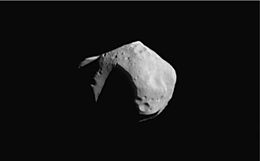
Asteroids, also called minor planets or planetoids, are a class of astronomical object. The term asteroid is generally used to indicate a diverse group of small celestial bodies that drift in the solar system in orbit around the Sun. Asteroid (Greek for "star-like") is the word used most in the English literature for minor planets, which has been the term preferred by the International Astronomical Union; some other languages prefer planetoid (Greek: "planet-
MINGE!!!!!!!!!
like"), because it more accurately describes what they are. In late August 2006, the IAU introduced the term "small solar system bodies" (SSSBs), which includes most objects thusfar classified as minor planets, as well as comets. At the same time they introduced the term dwarf planet for the largest minor planets. This article deals specifically with the minor planets that orbit in the inner solar system (roughly up to the orbit of Jupiter). For other types of objects, such as comets, Trans-Neptunian objects, and Centaurs, see Small solar system body.
The first asteroid to be discovered, Ceres, is the largest asteroid known to date and is now classified as a dwarf planet. All others are currently classified as small solar system bodies. The vast majority of asteroids are found within the main asteroid belt, with elliptical orbits between those of Mars and Jupiter. It is thought that these asteroids are remnants of the protoplanetary disc, and in this region the incorporation of protoplanetary remnants into the planets was prevented by large gravitational perturbations induced by Jupiter during the formative period of the solar system. Some asteroids have moons or are found in pairs known as binary systems.
Asteroids in the solar system
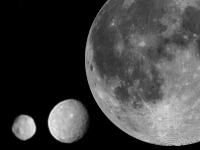
Hundreds of thousands of asteroids have been discovered within the solar system and the present rate of discovery is about 5000 per month. As of March 3, 2007, from a total of 368,650 registered minor planets, 152,554 have orbits known well enough to be given permanent official numbers.[1] Of these, 13,627[2] have official names.[3] The lowest-numbered but unnamed minor planet is (3708) 1974 FV1;[4] the highest-numbered named minor planet (other than the dwarf planet 136199 Eris) is 135268 Haigneré.[5]
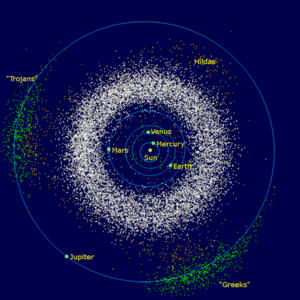
Current estimates put the total number of asteroids above 1 km in diameter in the solar system to be between 1.1 and 1.9 million.[6] The largest asteroid in the inner solar system is 1 Ceres, with a diameter of 900-1000 km. Two other large inner solar system belt asteroids are 2 Pallas and 4 Vesta; both have diameters of ~500 km. Vesta is the only main belt asteroid that is sometimes visible to the naked eye (in some very rare occasions, a near-Earth asteroid may be visible without technical aid; see 99942 Apophis).
The mass of all the asteroids of the Main Belt is estimated to be about 3.0-3.6×1021 kg,[7][8] or about 4% of the mass of our moon. Of this, 1 Ceres comprises 0.95×1021 kg, some 32% of the total. Adding in the next three most massive asteroids, 4 Vesta (9%), 2 Pallas (7%), and 10 Hygiea (3%), brings this figure up to 51%; while the three after that, 511 Davida (1.2%), 704 Interamnia (1.0%), and 3 Juno (0.9%), only add another 3% to the total mass. The number of asteroids then increases rapidly as their individual masses decrease.
Asteroid classification
Asteroids are commonly classified into groups based on the characteristics of their orbits and on the details of the spectrum of sunlight they reflect.
Orbit groups and families
Many asteroids have been placed in groups and families based on their orbital characteristics. It is customary to name a group of asteroids after the first member of that group to be discovered. Groups are relatively loose dynamical associations, whereas families are much "tighter" and result from the catastrophic break-up of a large parent asteroid sometime in the past.
For a full listing of known asteroid groups and families, see minor planet and asteroid family.
Spectral classification

In 1975, an asteroid taxonomic system based on colour, albedo, and spectral shape was developed by Clark R. Chapman, David Morrison, and Ben Zellner.[9] These properties are thought to correspond to the composition of the asteroid's surface material. Originally, they classified only three types of asteroids:
- C-type asteroids - carbonaceous, 75% of known asteroids
- S-type asteroids - silicaceous, 17% of known asteroids
- M-type asteroids - metallic, 8% of known asteroids
This list has since been expanded to include a number of other asteroid types. The number of types continues to grow as more asteroids are studied. See Asteroid spectral types for more detail or Category:Asteroid spectral classes for a list.
Note that the proportion of known asteroids falling into the various spectral types does not necessarily reflect the proportion of all asteroids that are of that type; some types are easier to detect than others, biasing the totals.
Problems with spectral classification
Originally, spectral designations were based on inferences of an asteroid's composition:[10]
- C - Carbonaceous
- S - Silicaceous
- M - Metallic
However, the correspondence between spectral class and composition is not always very good, and there are a variety of classifications in use. This has led to significant confusion. While asteroids of different spectral classifications are likely to be composed of different materials, there are no assurances that asteroids within the same taxonomic class are composed of similar materials.
At present, the spectral classification based on several coarse resolution spectroscopic surveys in the 1990s is still the standard. Scientists have been unable to agree on a better taxonomic system, largely due to the difficulty of obtaining detailed measurements consistently for a large sample of asteroids (e.g. finer resolution spectra, or non-spectral data such as densities would be very useful).
Asteroid discovery
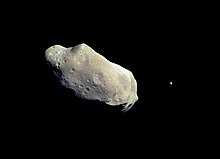
Historical methods
Asteroid discovery methods have drastically improved over the past two centuries.
In the last years of the 18th century, Baron Franz Xaver von Zach organized a group of 24 astronomers to search the sky for the "missing planet" predicted at about 2.8 AU from the Sun by the Titius-Bode law, partly as a consequence of the discovery, by Sir William Herschel in 1781, of the planet Uranus at the distance "predicted" by the law. This task required that hand-drawn sky charts be prepared for all stars in the zodiacal band down to an agreed-upon limit of faintness. On subsequent nights, the sky would be charted again and any moving object would, hopefully, be spotted. The expected motion of the missing planet was about 30 seconds of arc per hour, readily discernible by observers.
Ironically, the first asteroid, 1 Ceres, was not discovered by a member of the group, but rather by accident in 1801 by Giuseppe Piazzi, director of the observatory of Palermo in Sicily. He discovered a new star-like object in Taurus and followed the displacement of this object during several nights. His colleague, Carl Friedrich Gauss, used these observations to determine the exact distance from this unknown object to the Earth. Gauss' calculations placed the object between the planets Mars and Jupiter. Piazzi named it after Ceres, the Roman goddess of agriculture.
Three other asteroids (2 Pallas, 3 Juno, and 4 Vesta) were discovered over the next few years, with Vesta found in 1807. After eight more years of fruitless searches, most astronomers assumed that there were no more and abandoned any further searches.
However, Karl Ludwig Hencke persisted, and began searching for more asteroids in 1830. Fifteen years later, he found 5 Astraea, the first new asteroid in 38 years. He also found 6 Hebe less than two years later. After this, other astronomers joined in the search and at least one new asteroid was discovered every year after that (except the wartime year 1945). Notable asteroid hunters of this early era were J. R. Hind, Annibale de Gasparis, Robert Luther, H. M. S. Goldschmidt, Jean Chacornac, James Ferguson, Norman Robert Pogson, E. W. Tempel, J. C. Watson, C. H. F. Peters, A. Borrelly, J. Palisa, Paul Henry and Prosper Henry and Auguste Charlois.
In 1891, however, Max Wolf pioneered the use of astrophotography to detect asteroids, which appeared as short streaks on long-exposure photographic plates. This drastically increased the rate of detection compared with previous visual methods: Wolf alone discovered 248 asteroids, beginning with 323 Brucia, whereas only slightly more than 300 had been discovered up to that point. Still, a century later, only a few thousand asteroids were identified, numbered and named. It was known that there were many more, but most astronomers did not bother with them, calling them "vermin of the skies".
Manual methods of the 1900s and modern reporting
Until 1998, asteroids were discovered by a four-step process. First, a region of the sky was photographed by a wide-field telescope (usually an Astrograph). Pairs of photographs were taken, typically one hour apart. Multiple pairs could be taken over a series of days. Second, the two films of the same region were viewed under a stereoscope. Any body in orbit around the Sun would move slightly between the pair of films. Under the stereoscope, the image of the body would appear to float slightly above the background of stars. Third, once a moving body was identified, its location would be measured precisely using a digitizing microscope. The location would be measured relative to known star locations.[11]
These first three steps do not constitute asteroid discovery: the observer has only found an apparition, which gets a provisional designation, made up of the year of discovery, a letter representing the week of discovery, and finally a letter and a number indicating the discovery's sequential number (example: 1998 FJ74).
The final step of discovery is to send the locations and time of observations to Brian Marsden of the Minor Planet Center. Dr. Marsden has computer programs that compute whether an apparition ties together previous apparitions into a single orbit. If so, the object gets a number. The observer of the first apparition with a calculated orbit is declared the discoverer, and he gets the honour of naming the asteroid (subject to the approval of the International Astronomical Union) once it is numbered.
Computerized methods
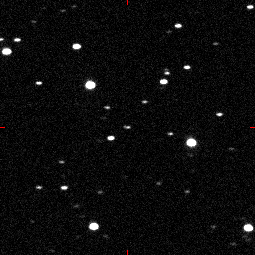
There is increasing interest in identifying asteroids whose orbits cross Earth's orbit, and that could, given enough time, collide with Earth (see Earth-crosser asteroids). The three most important groups of near-Earth asteroids are the Apollos, Amors, and the Atens. Various asteroid deflection strategies have been proposed.
The near-Earth asteroid 433 Eros had been discovered as long ago as 1898, and the 1930s brought a flurry of similar objects. In order of discovery, these were: 1221 Amor, 1862 Apollo, 2101 Adonis, and finally 69230 Hermes, which approached within 0.005 AU of the Earth in 1937. Astronomers began to realize the possibilities of Earth impact.
Two events in later decades increased the level of alarm: the increasing acceptance of Walter Alvarez' theory of dinosaur extinction being due to an impact event, and the 1994 observation of Comet Shoemaker-Levy 9 crashing into Jupiter. The U.S. military also declassified the information that its military satellites, built to detect nuclear explosions, had detected hundreds of upper-atmosphere impacts by objects ranging from one to 10 metres across.[citation needed]
All of these considerations helped spur the launch of highly efficient automated systems that consist of Charge-Coupled Device (CCD) cameras and computers directly connected to telescopes. Since 1998, a large majority of the asteroids have been discovered by such automated systems. A list of teams using such automated systems includes:[12]
- The Lincoln Near-Earth Asteroid Research (LINEAR) team
- The Near-Earth Asteroid Tracking (NEAT) team
- Spacewatch
- The Lowell Observatory Near-Earth-Object Search (LONEOS) team
- The Catalina Sky Survey (CSS)
- The Campo Imperatore Near-Earth Objects Survey (CINEOS) team
- The Japanese Spaceguard Association
- The Asiago-DLR Asteroid Survey (ADAS)
The LINEAR system alone has discovered 71,770 asteroids, as of November 9, 2006.[13] Between all of the automated systems, 4286 near-Earth asteroids have been discovered[14] including over 600 more than 1 km in diameter.
Naming asteroids
Overview: naming conventions
A newly discovered asteroid is given a provisional designation consisting of the year of discovery and an alphanumeric code (such as 2002 AT4). Once its orbit has been confirmed, it is given a number, and later may also be given a name (e.g. 433 Eros). The formal naming convention uses parentheses around the number (e.g. (433) Eros), but dropping the parentheses is quite common. Informally, it is common to drop the number altogether, or to drop it after the first mention when a name is repeated in running text.
Asteroids that have been given a number but not a name keep their provisional designation, e.g. (29075) 1950 DA. As modern discovery techniques are discovering vast numbers of new asteroids, they are increasingly being left unnamed. The first asteroid to be left unnamed was for a long time (3360) 1981 VA, now 3360 Syrinx; as of November 2006, this distinction is now held by (3708) 1974 FV1. On rare occasions, an asteroid's provisional designation may become used as a name in itself: the still unnamed (15760) 1992 QB1 gave its name to a group of asteroids which became known as cubewanos.
Numbering asteroids
Asteroids are awarded with an official number once their orbits are confirmed. With the increasing rapidity of asteroid discovery, asteroids are currently being awarded six-figure numbers. The switch from five figures to six figures arrived with the publication of the Minor Planet Circular (MPC) of October 19, 2005, which saw the highest numbered asteroid jump from 99947 to 118161. This change caused a small "Y2k"-like crisis for various automated data services, since only five digits were allowed in most data formats for the asteroid number. Most services have now widened the asteroid number field. For those which did not, the problem has been addressed in some cases by having the leftmost digit (the ten-thousands place) use the alphabet as a digit extension. A=10, B=11,…, Z=35, a=36,…, z=61. A high number such as 120437 is thus cross-referenced as C0437 on some lists.
Sources for names
The first few asteroids were named after figures from Graeco-Roman mythology, but as such names started to run out, others were used —famous people, literary characters, the names of the discoverer's wives, children, and even television characters.
The first asteroid to be given a non-mythological name was 20 Massalia, named after the city of Marseilles. For some time only female (or feminized) names were used; Alexander von Humboldt was the first man to have an asteroid named after him, but his name was feminized to 54 Alexandra. This unspoken tradition lasted until 334 Chicago was named; even then, oddly feminised names show up in the list for years afterward.
As the number of asteroids began to run into the hundreds, and eventually the thousands, discoverers began to give them increasingly frivolous names. The first hints of this were 482 Petrina and 483 Seppina, named after the discoverer's pet dogs. However, there was little controversy about this until 1971, upon the naming of 2309 Mr. Spock (which was not even named after the Star Trek character, but after the discoverer's cat who supposedly bore a resemblance to him). Although the IAU subsequently banned pet names as sources, eccentric asteroid names are still being proposed and accepted, such as 6042 Cheshirecat, 9007 James Bond, or 26858 Misterrogers.
Special naming rules
Asteroid naming is not always a free-for-all: there are some types of asteroid for which rules have developed about the sources of names. For instance Centaurs (asteroids orbiting between Saturn and Neptune) are all named after mythological centaurs, Trojans after heroes from the Trojan War, and trans-Neptunian objects after underworld spirits.
Another well-established rule is that comets are named after their discoverer(s), whereas asteroids are not. One way to "circumvent" this rule has been for astronomers to exchange the courtesy of naming their discoveries after each other. A particular exception to this rule is 96747 Crespodasilva, which was named after its discoverer, Lucy d'Escoffier Crespo da Silva, because she died shortly after the discovery, at age 22.[15][16]
Asteroid symbols
The first few asteroids discovered were assigned symbols like the ones traditionally used to designate Earth, the Moon, the Sun and planets. The symbols quickly became ungainly, hard to draw and recognise. By the end of 1851 there were 15 known asteroids, each (except one) with its own symbol.[17]
| Asteroid | Symbol |
|---|---|
| Ceres | Old planetary symbol of Ceres |
| 2 Pallas | |
| 3 Juno | |
| 4 Vesta | Old symbol of Vesta Old planetary symbol of Vesta |
| 5 Astraea | |
| 6 Hebe | |
| 7 Iris | |
| 8 Flora | |
| 9 Metis | |
| 10 Hygiea | |
| 11 Parthenope | |
| 12 Victoria | |
| 13 Egeria | Never assigned. |
| 14 Irene | "A dove carrying an olive-branch, with a star on its head," never drawn.[18] |
| 15 Eunomia | |
| 28 Bellona | File:28 Bellona symbol.png |
| 35 Leukothea | |
| 37 Fides | File:37 Fides symbol.png |
Johann Franz Encke made a major change in the Berliner Astronomisches Jahrbuch (BAJ, "Berlin Astronomical Yearbook") for 1854. He introduced encircled numbers instead of symbols, although his numbering began with Astraea, the first four asteroids continuing to be denoted by their traditional symbols. This symbolic innovation was adopted very quickly by the astronomical community. The following year (1855), Astraea's number was bumped up to 5, but Ceres through Vesta would be listed by their numbers only in the 1867 edition. A few more asteroids (28 Bellona,[19] 35 Leukothea,[20] and 37 Fides[21]) would be given symbols as well as using the numbering scheme. The circle would become a pair of parentheses, and the parentheses sometimes omitted altogether over the next few decades.[18]
Asteroid exploration
Until the age of space travel, asteroids were merely pinpricks of light in even the largest telescopes and their shapes and terrain remained a mystery.
The first close-up photographs of asteroid-like objects were taken in 1971 when the Mariner 9 probe imaged Phobos and Deimos, the two small moons of Mars, which are probably captured asteroids. These images revealed the irregular, potato-like shapes of most asteroids, as did subsequent images from the Voyager probes of the small moons of the gas giants.

The first true asteroid to be photographed in close-up was 951 Gaspra in 1991, followed in 1993 by 243 Ida and its moon Dactyl, all of which were imaged by the Galileo probe en route to Jupiter.
The first dedicated asteroid probe was NEAR Shoemaker, which photographed 253 Mathilde in 1997, before entering into orbit around 433 Eros, finally landing on its surface in 2001.
Other asteroids briefly visited by spacecraft en route to other destinations include 9969 Braille (by Deep Space 1 in 1999), and 5535 Annefrank (by Stardust in 2002).
In September 2005, the Japanese Hayabusa probe started studying 25143 Itokawa in detail and will return samples of its surface to earth. Following that, the next asteroid encounters will involve the European Rosetta probe (launched in 2004), which will study 2867 Šteins and 21 Lutetia in 2008 and 2010.
NASA is planning to launch the Dawn Mission in 2007, which will orbit 1 Ceres and 4 Vesta in 2011-2015, with its mission possibly then extended to 2 Pallas.
It has been suggested that asteroids might be used in the future as a source of materials which may be rare or exhausted on earth (asteroid mining), or materials for constructing space habitats (see Colonization of the asteroids).
Asteroids in fiction
A common depiction of asteroids (and less often, of Comets) in fiction is as a threat, whose impact on Earth could result with incalculable damage and loss of life.[22][23] This has a basis in scientific hypotheses regarding such impacts in the distant past as responsible for the extinction of the Dinosaurs and other past catastrophes —though, as they seem to occur within tens of millions of years of each other, there is no special reason (other than creating a dramatic story line) to expect a new such impact at any close millennium.
Another way in which asteroids could be considered a source of danger is by depicting them as a hazard to navigation, especially threatening to ships traveling from Earth to the outer parts of the Solar System and thus needing to pass the Asteroid Belt (or make a time- and fuel-consuming detour around it). In this context, asteroids serve the same role in space travel stories as reefs and underwater rocks in the older genre of sea-faring adventure stories.[24] And like reefs and rocks in the ocean, asteroids as navigation hazards can also be used by bold outlaws to avoid pursuit. Representations of the Asteroid Belt in film tend to make it unrealistically cluttered with dangerous rocks. In reality asteroids, even in the main belt, are spaced extremely far apart.
Before colonization of the asteroids became an attractive possibility, a main interest in them was theories as to their origin - specifically, the theory that the asteroids are remnants of an exploded planet. This naturally leads to SF plotlines dealing with the possibility that the planet had been inhabited, and if so - that the inhabitants caused its destruction themselves, by war or gross environmental mismanagement. A further extension is from the past of the existing asteroids to the possible future destruction of Earth or other planets and their rendering into new asteroids.[25][26]
When the theme of interplanetary colonization first entered SF, the Asteroid Belt was quite low on the list of desirable real estate, far behind such planets as Mars and Venus (often conceived as a kind of paradise planet, until probes in the 1960s revealed the appalling temperatures and conditions under its clouds). Thus, in many stories and books the Asteroid Belt, if not a positive hazard, is still a rarely-visited backwater in a colonized Solar System.[27]
The prospects of colonizing the Solar System planets became more dim with increasing discoveries about conditions on them. Conversely, the potential value of the asteroids increased, as a vast accumulation of mineral wealth, accessible in conditions of minimal gravity, and supplementing Earth's dwindling resources. Stories of asteroid mining became more and more numerous since the late 1940s, with the next logical step being depictions of a society on terraformed asteroids —in some cases dug under the surface, in others having dome colonies and in still others provided with an atmosphere which is kept in place by an artificial gravity. An image developed and was carried from writer to writer, of "Belters" or "Rock Rats" as rugged and independent-minded individuals, resentful of all authority (in some books and stories of the military and political power of Earth-bound nation states, in others of the corporate power of huge companies).[28] As such, this sub-genre proved naturally attractive to writers with Libertarian tendencies.[29] Moreover, depictions of the Asteroid Belt as The New Frontier ( the High Frontier in the opening of Jack Williamson's Seetee Ship) clearly draw (sometimes explicitly) on the considerable literature of the Nineteenth-Century Frontier and the Wild West.
Notes
- ^ "Minor Planet Statistics". Retrieved 2007-03-10.
- ^ "Minor Planet Names". Retrieved 2007-03-10.
- ^ trivia: about 650 of these names require diacritics
- ^ "Discovery Circumstances: Numbered Minor Planets (1)-(5000)". Retrieved 2006-10-11.
- ^ "Discovery Circumstances: Numbered Minor Planets (135001)-(140000)". Retrieved 2006-07-12.
- ^ "New study reveals twice as many asteroids as previously believed". Retrieved 2006-03-28.
- ^ Krasinsky, G. A.; Pitjeva, E. V.; Vasilyev, M. V.; Yagudina, E. I. (2002). "Hidden Mass in the Asteroid Belt". Icarus. 158 (1): 98–105.
{{cite journal}}: CS1 maint: multiple names: authors list (link) - ^ Pitjeva, E. V. (2005). "High-Precision Ephemerides of Planets - EPM and Determination of Some Astronomical Constants". Solar System Research. 39: 176.
- ^ Chapman, C. R., Morrison, D., & Zellner, B. (1975). "Surface properties of asteroids: A synthesis of polarimetry, radiometry, and spectrophotometry". Icarus. 25: 104–130.
{{cite journal}}: CS1 maint: multiple names: authors list (link) - ^ McSween Jr., Harry Y. Meteorites and Their Parent Planets. ISBN 0-521-58751-4.
- ^ "Carolyn Shoemaker". Retrieved 2003-06-23.
- ^ "Near Earth Object Program". Retrieved 2004-06-23.
- ^ "Minor Planet Discover Sites". Retrieved 2006-07-12.
- ^ "Unusual Minor Planets". Retrieved 2006-07-14.
- ^ "Citation from MPC 55988". Retrieved 2006-06-05.
- ^ "MIT News Office: Lucy Crespo da Silva, 22, a senior, dies in fall". Retrieved 2006-06-05.
- ^ Gould, B. A. (1852). "On the Symbolic Notation of the Asteroids". Astronomical Journal. 2: 80.
- ^ a b Hilton, James L. (September 17, 2001). "When Did the Asteroids Become Minor Planets". Retrieved 2006-03-26.
- ^ Encke, J. F. (1854). "Beobachtung der Bellona, nebst Nachrichten über die Bilker Sternwarte". Astronomische Nachrichten. 38: 143.
- ^ Rümker, G. (1855). "Name und Zeichen des von Herrn R. Luther zu Bilk am 19. April entdeckten Planeten". Astronomische Nachrichten. 40: 373.
{{cite journal}}: Unknown parameter|coauthors=ignored (|author=suggested) (help) - ^ Luther, R. (1856). "Schreiben des Herrn Dr. R. Luther, Directors der Sternwarte zu Bilk, an den Herausgeber". Astronomische Nachrichten. 42: 107.
- ^ Clarke, Arthur C. (1993). The Hammer of God.
- ^ Niven, Larry (1977). Lucifer's Hammer.
- ^ Asimov, Isaac (1953). Lucky Starr and the Pirates of the Asteroids.
- ^ Hogan, James P. (1977). Inherit the Stars.
- ^ Heinlein, Robert (1948). Space Cadet.
- ^ Asimov, Isaac (March 1939). "Marooned off Vesta". Amazing Stories.
- ^ Williamson, Jack (1950). Seetee Ship.
- ^ Smith, L. Neil (1993). Pallas.
See also
- Asteroid belt
- BOOTES (Burst Observer and Optical Transient Exploring System)
- Category:Asteroid groups and families
- Category:Asteroids
- List of asteroids
- List of asteroids named after important people
- List of asteroids named after places
- List of noteworthy asteroids
- Meanings of asteroid names
- Category:Binary asteroids
- Minor planet
- Minor Planet Center
- Near-Earth object
- Impact event
- Pronunciation of asteroid names
External links
- Known Asteroid Impacts & Their Effects
- Alphabetical list of minor planet names (ASCII) (Minor Planet Center)
- Alphabetical and numerical lists of minor planet names (Unicode) (Institute of Applied Astronomy)
- Near Earth Objects Dynamic Site
- Asteroids Dynamic Site Up-to date osculating orbital elements and proper orbital elements
- Asteroid naming statistics
- Near Earth Asteroid Tracking (NEAT)
- Everything you wanted to know about comets and asteroids — Provided by New Scientist.
- Spaceguard UK
- When Did the Asteroids Become Minor Planets?
- Large amount of information on asteroid groups collected by Gérard Faure, translation Richard Miles.
- Asteroid Simulator with Moon and Earth

